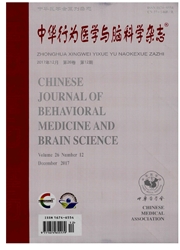

 中文摘要:
中文摘要:
目的探究抑郁症患者在处理情绪刺激时,脑岛与腹侧系统脑区之间的效能连接情况及其与临床相关性。方法选取27例抑郁症患者和27例健康对照者进行脑磁图扫描,选取悲伤表情刺激下的脑磁信号。选取的感兴趣脑区包括脑岛、杏仁核、前扣带回、眶额回和腹内侧前额叶。应用SPM8软件进行数据预处理及源重建,提取感兴趣时间窗0~600ms时间序列,进行主成分方法降维,利用格兰杰因果模型进一步计算效能连接值。结果抑郁症患者眶额回到前扣带回效能连接增强(P=0.016),脑岛到腹内侧前额叶(P=0.022),及前扣带回到脑岛的效能连接(P=0.006)均较健康对照者增强,差异具有统计学意义。前扣带回到脑岛的效能连接与临床有效病程呈正相关(r=0.392,P〈0.05)。结论抑郁症在处理负性情绪刺激时,脑岛与前扣带回及腹内侧前额叶脑区效能连接增强,提示对负性刺激处理增强。本研究结果提示脑岛不仅在抑郁症患者静息态中起着重要作用,且在处理情绪任务中也起着重要作用。
 英文摘要:
英文摘要:
Objective To investigate the functional connectivity of the insula with ventral neural system and the relationship with the clinical feature during emotion processing in major depressive disorder. Methods T- wenty-seven patients with major depressive disorder(MDD) and well-matched healthy controls were enrolled in this study. They were asked to recognize the facial emotion during magnetoencephalograph (MEG) scanning. Then the magnetic signals of the sad face was extracted and further processed with the software of SPM8 ,with the interested regions including the amygdala (AMYG), the insula, the anterior cingulate cortex( ACC ), the orbitofrontal cortex (OFC) and the ventromedial prefrontal cortex (VMPFC). The interested time series were selected between 0-600 ms ,which was analyzed by the method of principal component analysis (PCA) to reduce the differences. The next step was to compute the effective connectivity of the interested brain areas with the approach of granger causality model(GCM). Results The effective connectivity from the OFC to the ACC was obviously enhanced in MDD(P= 0.016) ,in addition with the connectivity from the insula to the VMPFC(P= 0.022) and the ACC(P= 0.006) to the insula. Furthermore, the value of the connectivity from the anterior cingulate cortex to the insula was positively cor- related with the illness duration( r= 0.392, P〈0.05). Conclusions The enhanced connectivity of the increased communication between them,indicating the enhancement of the processing of sad stimuli. Our resuhs indicate that the insula plays a pivotal role,not only in the resting-sate,but also in the emotion processing task.
 同期刊论文项目
同期刊论文项目
 同项目期刊论文
同项目期刊论文
 期刊信息
期刊信息
